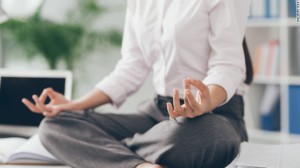“Sedentary workforce” is an unfortunately accurate description of the millions of people whose jobs keep them desk bound. There’s little else in corporate America as taxing on the mind and body as being trapped in a cube all day.
Even if you aren’t an office worker, if your career demands long bouts of desk sitting, you can relate to symptoms such as brain fog, anxiety, poor posture, back pain and lower-body lethargy. Thankfully, more companies are not only recognizing the health dangers of prolonged sitting, but also the negative impact on productivity and morale. As such, they’re wising up to the benefits of yoga in the workplace.
To reap the rewards of office yoga, you don’t need to sacrifice your lunch hour for class, stand on your head in the break room, or chant “OM” loudly at your desk. You can easily integrate yoga into your workday in subtle ways that deliver big benefits — without freaking out your co-workers or requiring pretzel-like flexibility.
Here are five techniques most anyone can do right at their desk:
1. Train your brain and breathing to work for you
Studies have shown that practicing mindfulness meditation, merely focusing on something in the present moment, like your breath, has a positive impact on the parts of our brain associated with attention monitoring and working memory.
One study, from the University of Washington, even showed an increase in the ability to multitask. If you combine diaphragmatic breathing with meditation, you can also mitigate your stress response, lowering blood pressure, heart rate and cortisol (stress hormone) production.
It’s a common misperception that meditation is a long, complicated practice in a quiet environment. It can be done in the midst of a busy office in as little as two minutes and still have a profound impact.
Minibreathing meditation
Lowers blood pressure, heart rate and stress hormone production; improves concentration, memory and ability to multitask.
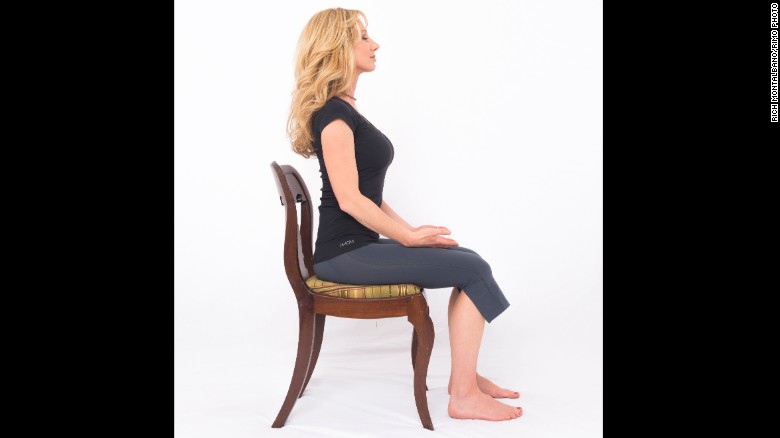
Sit comfortably with both feet on the floor. Establish good posture by exhaling as you drop your ribcage down in front and your shoulder blades down in back.
Rest your hands on the tops of your legs with your palms up. Close your eyes. Relax your jaw, resting your lips in a slight smile. Take conscious control of your breathing, emphasizing your first few exhales, like sighs of relief. Tune out distractions, focusing all of your attention on expanding your lower ribs on inhalation and contracting them on exhalation.
Try breathing long and deep at the following pace: 5-count inhale, 7-count exhale. Once you’ve established a comfortable breathing rhythm, count your breaths backwards from 10 to one.
Open your eyes and notice your profound change in perspective.
2. Get off your butt and give your body a break
To combat the adverse health effects of prolonged sitting, most health care professionals recommend getting up every 20 or 30 minutes for at least two minutes. Set a timer on your computer to prompt you. When you stand, it’s a good idea to stretch the muscles you’ve been sitting on by practicing a hip opener.
Figure-four hip opener
Opens the hip joint and deeply stretches glute (buttock) muscles.

Bracing yourself by holding your chair or desk, shift your weight to your left leg. Place your right foot on your left thigh above your knee in a figure-four position.
Exhale as you sit back as deeply as you can without discomfort. Hold for five long, deep breaths. Repeat on the other side.
3. Attend to gravity-stricken sitting muscles
When we sit inactively, gravity takes its toll, compressing side waist muscles, inhibiting deep core muscles and feeding into hip flexor tension. It’s no wonder sitting makes us feel so stiff.
Savvy desk jockeys can employ an “active” sitting option in place of their regular office chair by using a stability ball or a chair ergonomically designed for active sitting. Everyone can give gravity-stricken sitting muscles attention with simple standing yoga stretches, such as Warrior One.
Warrior One with hip flexor release
Releases overactive hip flexors and elongates compressed side waist muscles while activating deep core muscles for balance.
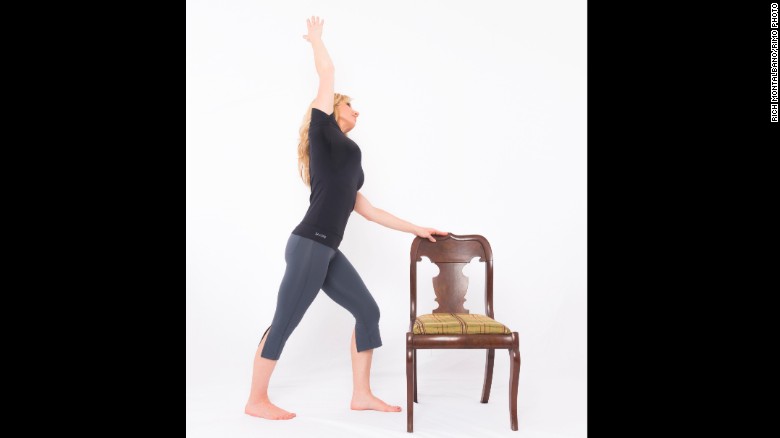
Place your left hand lightly on top of your chair or desk, step your right foot back into a short lunge. Drop your back heel and point your toes out slightly. Bend your front knee to align above your ankle, keeping your back leg straight. Inhale as you lift your right arm up and over your head. Exhale as you side bend to the left.
Keep your core activated for balance and avoid arching your lower back. Press the front of your right hip forward to release your right hip flexors. Hold for three long, deep breaths. Repeat on the other side.
4. Revitalize tired legs and boost circulation
Varicose veins and swollen ankles are no strangers to office workers. Sitting or even standing for prolonged periods can stifle circulation and lead to edema and spider veins. That’s why it’s important to actively reposition your legs under and around your seat while sitting, but also to get up and stretch them out to enhance blood flow.
Standing hamstring stretch
Stretches hamstring and calf muscles; increases leg circulation.
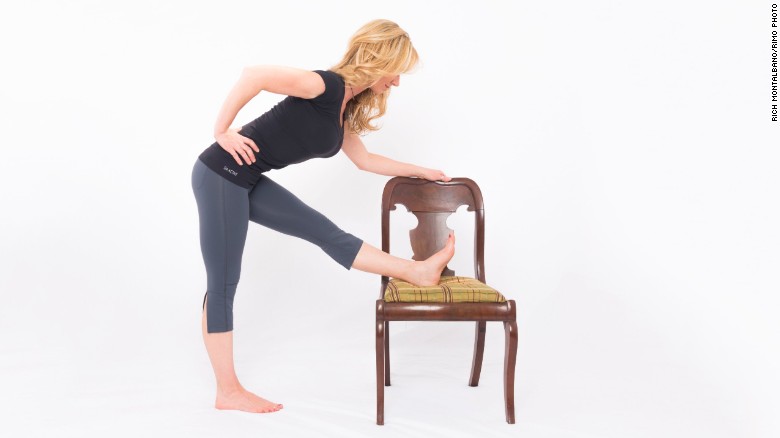
While holding your chair back or desk for balance, place your left foot on the seat of your chair. If necessary, lower your chair height to a safe, comfortable level.
Keep your hips squared and your left toes in dorsi flexion (pointing up). Exhale as you flex from your hips, as opposed to rounding your back, to bend forward toward your leg. Hold for three long, deep breaths. Repeat on the other side.
5. Twist away tension and improve posture
Not every office yoga move involves getting out of your chair. It’s essential to practice awareness of your seated posture and avoid leaning into a pain-inducing slump at your desk.
The simplest and most effective way to correct your slouch is to activate the underused muscles in your midback that are inhibited by the overactive muscles in your upper back, chest and neck that pull you forward. You can do this with an easy seated reach-back twist that simultaneously releases upper-body tension while strengthening and activating midback muscles that support good posture.
Seated twist with reach back
Increases midback mobility and releases overworked upper back and neck muscles; promotes proper shoulder blade positioning for better posture.
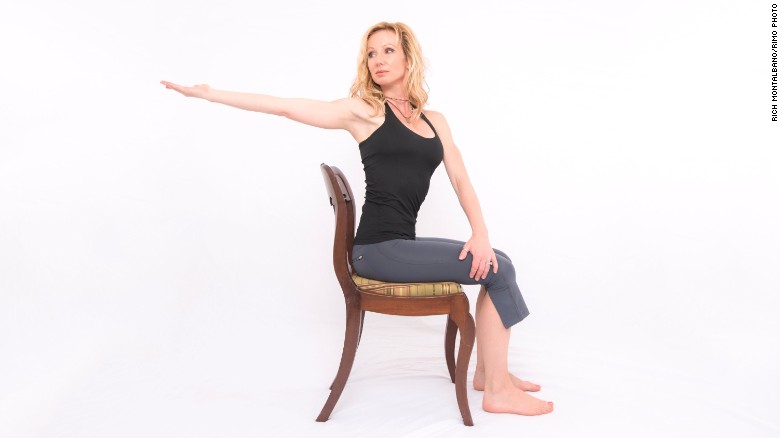
From a seated position at your desk, inhale as you reach your right arm forward at shoulder height with your palm up. Exhale as you reach back to the right, internally rotating your left lower ribcage to facilitate the twist. Activate the muscles just below your right shoulder blade to pull it down toward your waist and slightly in toward your spine. Hold for three long, deep breaths. Repeat on the other side.
If your chair back is higher than shoulder level, you’ll need to angle your lower body so that your knees point in the opposite direction you’re twisting to give you enough room to reach behind you.
Note of caution for anyone with wheels on their office chair: before doing postures that require support from your chair, either lock the wheels or hold onto a desk or wall instead.
From: CNN

